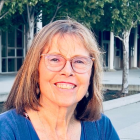Support strong Canadian climate journalism for 2025
These in-their-own-words pieces are told to Patricia Lane and co-edited with input from the interviewee for the purpose of brevity.
Chaz Garraway helps coastal people adapt to climate change.
This 23-year-old engineer co-founded and co-led a movement to plant a million and a half trees across the Caribbean and now works in coastal restoration.
I chatted with him at his home in Ottawa.

Tell us about the tree-planting project.
In 2019, hurricane Dorian devastated my Bahamian homeland. I went to the United Nations climate change summit later that year to talk about how we must adapt to the reality that these kinds of storms are a part of our lives. The connections I made there led to a small group of young people leading a plan to plant one million trees across the Caribbean to protect our land and beaches called the Caribbean Tree Planting Project.
Starting in 2020, we used our networks and social media, encouraging young people across the region to form groups and decide what kinds of trees should be planted and the kinds of adaptation needed at each locale.
Our team planted sea oats (Uniola paniculata), a tall plant with deep roots crucial to the formation of dunes and the re-establishment of coastal ecosystems. The oats feed animals like rabbits and birds. Local people also wanted food-bearing trees, so we planted mangoes, guavas and other fruit trees.
We set ourselves a goal of a million trees, but there was so much support and enthusiasm on the ground with schools and governments also getting involved, that by the end of 2021, we had planted half a million more, with two million now within sight.
The trees are an important adaptation to the changing climate, but so are the groups of people who formed to plant them. Before Dorian, storms were often seen as just part of life and we tended to shrug them off and carry on. But Dorian brought so much damage and loss that many were demoralized. The tree-planting project allows young people to experience leading the creation of active communities determined to work together to protect our land and ocean. People involved know they are building a new kind of resilience.
Tell us about your current work.
I research and design solutions to protect existing coasts and mitigate erosion and storm surges. This might mean supporting communities to install nature-based solutions such as expanding tidal wetlands or designing and building fixed barriers for water management.

Tell us about your background.
I was born and raised in the Bahamas and came to Halifax to study engineering. My dad is a civil engineer and I grew up believing that well-designed things work. My mother taught me to engage respectfully with a wide range of people and that if one gives kindness, it gets returned. I was also raised to believe that being able to turn to God sometimes helps one to step back and gain a larger perspective.
What worries you?
Social media may use a startling headline to grab our attention, but I worry that we must learn to go deeper. For example, we may see a headline about sea level rise that might alarm us or we might pass it by if we are not feeling directly touched. I hope people can lean into their local communities and understand how their own places will be affected.
Averages are often not very helpful. In your own area, sea levels might rise far more or much less. It is only by understanding the details that we can work to adapt appropriately. If we just go with averages, we might misallocate resources when the money might be better spent on a different form of climate adaptation that will actually help.
There is a strong tendency to foreground mitigation over adaptation. Sometimes working on adaptation can appear to be giving up and accepting that emissions are going to rise and, of course, it is important to keep working to bring them down. But even at current levels of emissions, we are in for a wild ride with plenty of hardship. We must adapt in order to reduce suffering as much as possible.

What do you see as the possibilities if we get this right?
Every attempt at mitigation and each adaptive project will bring new opportunities and new kinds of work and interaction. Whether your adaptive project helps keep your beach beautiful, cleans the air in your city or regenerates biodiversity and cleans the water in wetlands, life can be so much better.
What would you like to say to other young people?
Be encouraged. There are so many people with different skills, talents, passions and aptitudes working on this. If you are worried, you are not alone. Your concerns can lead you to be part of the world of solutions.
Read. Don’t take things at face value. The climate crisis is complex and so are the solutions.
How about older readers?
You have more life experience. Model curiosity and engagement with new ideas to help us all to ask better questions.







Comments